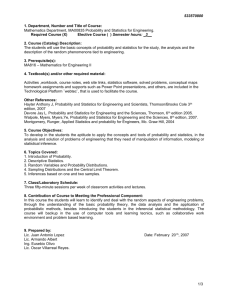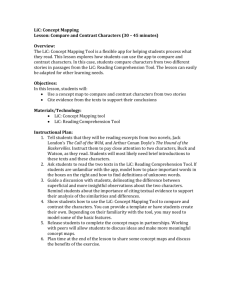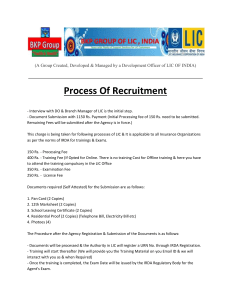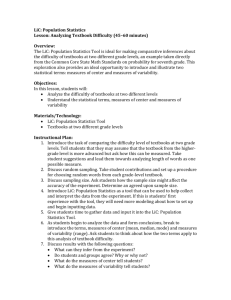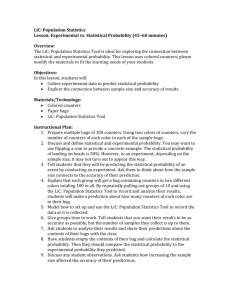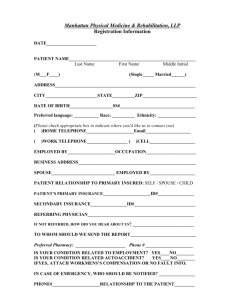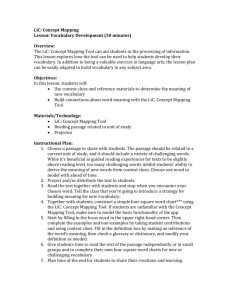MARK`S ANNUAL MEETING / FINANCIAL REPORT
advertisement
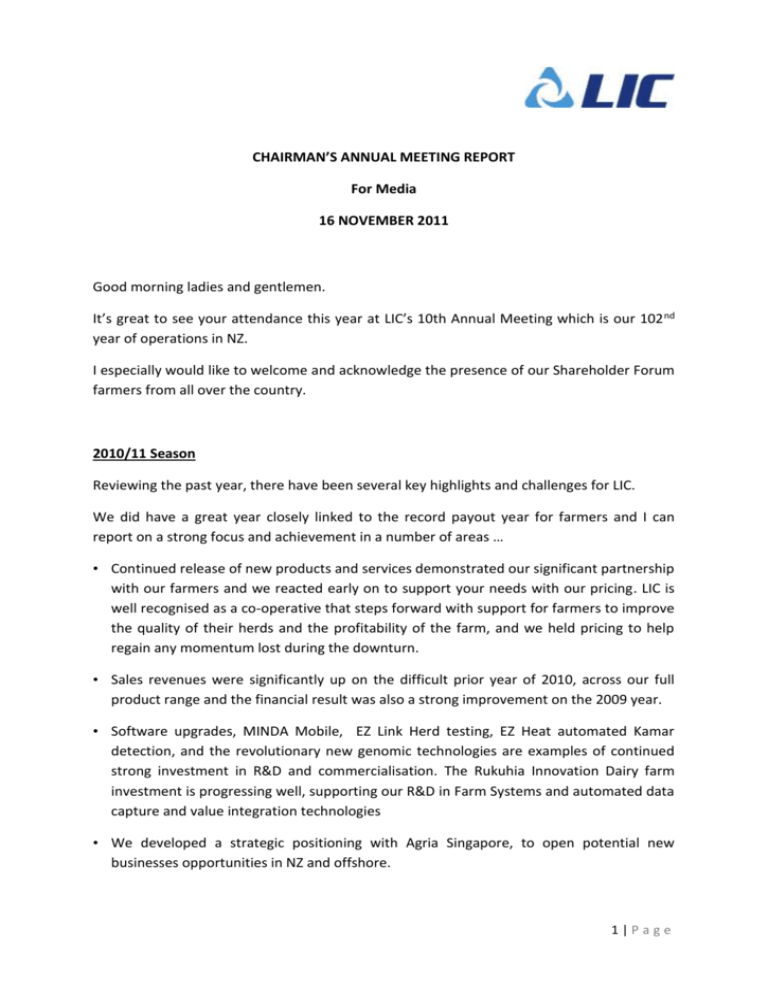
CHAIRMAN’S ANNUAL MEETING REPORT For Media 16 NOVEMBER 2011 Good morning ladies and gentlemen. It’s great to see your attendance this year at LIC’s 10th Annual Meeting which is our 102 nd year of operations in NZ. I especially would like to welcome and acknowledge the presence of our Shareholder Forum farmers from all over the country. 2010/11 Season Reviewing the past year, there have been several key highlights and challenges for LIC. We did have a great year closely linked to the record payout year for farmers and I can report on a strong focus and achievement in a number of areas … • Continued release of new products and services demonstrated our significant partnership with our farmers and we reacted early on to support your needs with our pricing. LIC is well recognised as a co-operative that steps forward with support for farmers to improve the quality of their herds and the profitability of the farm, and we held pricing to help regain any momentum lost during the downturn. • Sales revenues were significantly up on the difficult prior year of 2010, across our full product range and the financial result was also a strong improvement on the 2009 year. • Software upgrades, MINDA Mobile, EZ Link Herd testing, EZ Heat automated Kamar detection, and the revolutionary new genomic technologies are examples of continued strong investment in R&D and commercialisation. The Rukuhia Innovation Dairy farm investment is progressing well, supporting our R&D in Farm Systems and automated data capture and value integration technologies • We developed a strategic positioning with Agria Singapore, to open potential new businesses opportunities in NZ and offshore. 1|Page • We had to respond to the NZAEL board decision to remove genomics from LIC bull proofs. • We also unfortunately had to go to the High Court to defend our intellectual property rights pertaining to a group of bulls that had not been given any waiver rights to a competitor to breed or market. • We have also been in negotiations with DairyNZ around the recommendations from the Anderson Report that was commissioned in 2008, and we were not impressed with the way it was taken into the public arena. I will now cover most of these areas with you. Financial The Board is delighted with this excellent financial result for the year and the CEO will cover the financials more fully in his report. Annual Dividend 2011 Total dividend to shareholders was $13.7M. This represented 80% of Underlying Earnings and was at the top end of our policy range. This has been a very strong result which was achieved through the delivery of an everwidening range of herd and farm improvement products, and it reflects our strong farmercustomer driven focus. Co-operative Strength As at 31 May 2011 balance date, the Share Register recorded 10,728 shareholders (10168) a net increase of 560. We had 4,328,207 million Co-operative Control Shares on issue at balance date (4.65M) – a small decrease of 0.32M based on 2009 downturn, however with the July update that increased to 10,999 (+ 5,182,355) representing the real growth in last year’s business. There are 8,690 Investment shareholders holding 29.5 million Investment Shares on issue, an average holding ratio of 8 per co-op share. 2|Page On - market and via the Voluntary Investment scheme, dividend re-investment plan and staff share plan, 3,033 shareholders traded 1.1M Investment shares at a total value of $3.2M. Shareholder Value “LIC – This is my Co-op” Shareholder Value comes in many ways: Firstly as a co-op owner you retain absolute control of the company and you have first rights to any dividend which covers the cost of funding co-op shares. This removes any barrier to entry to LIC for farmers including sharemilkers, and for those who are growing their business with us. With the risk of this sounding like a sales pitch I can say we are proud to claim that our co-op offers: The best products and services, investment & innovation, offering heaps of choice for farmers. We have the best and biggest range of bulls, in DNA selected or traditional teams and with choice of breeds, using DIY/Tech, world leading LLL or frozen, SGL/OAD options, nominated or PS, all offering the best genetic gain available, but allowing customers to choose. LIC has the best 1000 strong technician service in the world plus DataMATE management of CR’s, inbreeding and CVM, that has watched over 30 million matings in the last decade. We have a back-up plan if things go wrong, great staff on hand to help with service from farm-side to the best call centre in world. We offer the best Herd testing range with traditional and the latest new technology backed by herd and farm recording products in the expanding MINDA suite. Best turnaround times and best DNA parentage service from on-farm samplers to accurate results and disease monitoring service A wide shed automation product range, and the list continues All this combines to deliver value much greater than the sum of the parts so as we partner with you to improve your cow, herd and farm management we believe LIC can be your greatest driver of on-farm production and profit. We can confidently say this because of our very high market shares year after year across the products and services and support we offer. I can’t think of another co-op or company that has someone on your farm for 30-60 days or more of the year other than your tanker 3|Page driver. I also regularly hear that Kiwi’s farming offshore quickly realise how much they took our products and services for granted. Shareholder Value “LIC – This is my Co-op” We are unique in the world as a fully integrated farm improvement co-op, including farm management consultants, with improving farmer profits at the very core of our business. We are also unique with our strong sharemilker ownership. What value do we get? DairyNZ’s Dairy Base 2010 Economic Survey of farm operating expenditure show costs for “Breeding and Herd Improvement” which are mostly but not all LIC direct costs, as 9 cents/kg MS in 2001 and 11c in 2010. As a percentage of farm operating expenditure, it was 3.5% in 2001 and decreased to 3.0% in 2010. Farm operating expenditure was $2.57/kg MS and increased to $3.56 or +39% for the decade. Total production/farm over the decade has increased by 62%, and two-thirds of on-farm production is driven by genetics, technology and information that LIC provides our farmers. Genetic gain in its own right will be discussed further shortly but suffice to say that the cost per cow in -calf including technician costs plus the best bulls available we believe to be among the lowest in the world. A further benefit to note is that millions of records show that high BW animals produce more and earn more, and that is not unnoticed by bank managers nor land owners wanting top sharemilkers, so typically that is represented in cattle sales and stock valuations varying by $100’s per cow. Shareholder Value “LIC – This is my Co-op” Our 5th Co-operative principle states that Shareholders co-operate with the Company and each other, including the sharing of information, to promote their common interests. Our own individual on farm data has limited intrinsic value but by pooling our data together and employing skilled “data scientists” using the latest software and hardware we generate a vast amount of added value information that drives our decision making and farm productivity and in turn builds up valuable intellectual property for our future. 4|Page Farmer user groups add tremendous value to product development as do for example widespread scale confirmation of semen diluents, dose rates, etc across the LIC herd as we have done for 50 years. This may be a surprise to some that we work together for the common good in many ways that are not immediately obvious. Our low group conception rate support is also unique in the world, as is our drive to improve in-calf rates which could see less semen used. We advertise overseas that we are the only AB company whose goal is not to sell a farmer more semen, rather to deliver better and more fertile cows. Shareholder Value “LIC – This is my Co-op” Genetic gain has been accumulating and compounding at 1.5%/year or plus 10-11 BW points in the national herd delivering 4-5 kgs MS/cow increase per year. Traditionally this has occurred through the SPS scheme using 400 herds to gather data at a cost to LIC of about $100M since 2001. We celebrated 50 years of the Sire Proving Scheme at the Fieldays with PM John Key cutting the birthday cake and we acknowledged Dr Pat Shannon as the billion dollar man who still works for LIC having done so for over 50 years. He along with Olive Castle designed the scheme, and Pat pioneered many world leading technologies and we are launching a book next month that captures all this history. But in addition to this we have been pioneering a game changing technology in the field of genomics that enables us to crack the long generation interval barrier and use a team of elite young sires under the DNA proven banner. The strength of our co-op is that we underpin the farm, the factories balance sheets, the nutritious dairy food for the world, and the nation benefits in turn. National good is an important by-product through the ripple effect and our taxes, just as industry good benefits from the increasing levies that they derive from what we do so well, to in turn invest in R&D and extension. This is my (and our) co-op at work. 5|Page Shareholder Value “LIC – This is my New Generation Co-op” But Shareholder Value also comes from being an Investment shareholder in our New Generation Co-operative. We can be rightly proud of our unique integrated farm improvement New Generation Co-op model that we introduced in 2004. We were first to introduce trading among farmers, and we removed our redemption risk so we don’t fear the low tides of drought or downturns washing capital out of our balance sheet. It is completely over to our farmer members who control this co-op to decide whether or how many shares up to a limit of 5% that they would like to hold. And the capital gain is significant, as we have doubled the business in the last 5-6 years, the share price has grown over 2.5x reaching $4.15 or $122M on farmers balance sheets from zero pre-DIRA 2001. In addition to dividends, trading among farmers allows access to one’s capital if other needs arise or when a farmer exits our co-op. Dividend We noted that Co-op shareholders have first rights to dividends but every dollar that is not invested for future generations, returns to our investment shareholders who fund the co-op and have their capital at risk in the business. So this is our New Generation co-operative but how have returns been over time? This graph shows the annual dividends that we have returned to shareholders since 2004 totalling $65M and it represents a significant benefit to owners of co-operative and investment shares. 6|Page 7-Year Share History When we first introduced trading among farmers by listing on the NZAX back in 2004 the shares were valued by two independent parties at around $1.39 each. This graph shows the changes since then. The share price reached $3.65 at balance date 2011 and are currently (16 Nov) trading at $4.15 (see the red star) [POINT WITH LASER] with a market capitalisation about $122M, and this is represented on our farmer-owners’ balance sheets. This is unique in the world of Farm & Herd Improvement. However LIC shares are trading at a discount of 35% of their NTA value which is $6.27 /share. Agria Singapore In April I wrote to shareholders informing of LIC support for the Agria/New Hope/Ngai Tahu partial takeover of PGG Wrightson. LIC extended a loan of $NZ10m to Agria Singapore for a period of 18 months. Security for the loan is provided by Agria and the loan has been made at commercial interest rates and terms. LIC has appointed Mark Dewdney as a director to the Board of Agria Singapore. We supported the takeover because the challenge to maintain and grow profitability in dairying comes down to great people and to maximising production from your land and your herd. As discussed the fact that over 60% of farm productivity comes from genetics and 40% from farm management underlines the role LIC has today, on your farm. So two of the biggest drivers to your profitability are genetics and grass and we well know that it’s one thing to have superior, high genetic cows but another to feed them well. Our industry has always been regarded as one of the most efficient in the world by virtue of our ability to grow grass and we believe there is potential to improve grass species to ensure we are able to fully feed the elite animals on our farms. We did not becoming a shareholder in either PGGW or Agria Singapore, and our intention (beyond this loan) is to be in a closer position to consider investing in a separate PGGW AgriTech (ie pasture and forage genetics) business, should such a structure ever be established by PGGW. Our strong relationship with Agria and New Hope also gives us a unique avenue to make LIC genetics available to the rapidly growing Chinese dairy industry – remembering that profits from our sales overseas returns to LIC farmer shareholders, and does not constitute ‘taking our eye off the ball’ of our primary role – which is the New Zealand dairy industry. We are also steadily building our relationships with Iwi such as Ngai Tahu in this country who are dynamic and long term players in our vibrant industry. 7|Page NZAEL & Genomics In 1994 LIC began an amazing journey investing in early DNA technology to investigate genetic markers and eventual gene discovery. Some $30M dollars later, we are now able to confidently sell a group of young sires based on analysis of their DNA. The human genome was cracked in 2003 for a cost of US $1Bn over 13 years. The rat genome cost US$100M 2 years later and today we are sequencing the complete genome of a range of individual elite LIC sires as part of the Primary Growth Partnership sequencing program. Each has 3 Bn base pairs churning out 16 Bn data points so computers are moving into petabytes now from terrabytes of storage under traditional systems, and gigabytes are what we think of in our home computers. We are at the cutting edge driving the science and our scientists are regularly peer reviewed by 2 of the best experts in the world in these fields. We have screened 3600 proven bulls and 16,000 cows under the current appropriate technologies which continue to get better and better. We also screen 1500 bull calves annually to select the All Blacks from the cradle and by pass the regional playoffs and the league scouts. There are those in the industry who are struggling to keep up with the sheer pace of change, just as the introduction of AB itself posed threats yet massive opportunities. I had to take the unprecedented step of writing an open letter to all farmers after NZAEL rejected genomics from the BW in April 2011. An early bias recognised in the science worldwide in genomic proofs has been steadily adjusted for, but no other country withdrew it from their indexes. LIC was forced to set up a genomic BW to protect the massive scientific investment that farmers have in this technology. We will continue down this path with genomics as this is the way of the future as the science continues to improve. In July 2010 monitor teams of all three breeds totalling 48 bulls from the 2007 SPS intake were selected and reported to the LIC Board in advance of their SPS daughter proofs and their performance was within 5 BW units of the prediction. We have identified from the current part season progeny test information that there was slippage in our predicted BW for some of the 2008 and 2009 DNA Proven Premier Sires Teams. We are disappointed with the early season results. As part of our ongoing improvement to Genomic Selection methods, in the 2010 and 2011 seasons, we applied improved genomic bias correction factors to better account for these differences. 8|Page The LIC Board commitment is to continue to monitor DNA Proven Daughter performance through the remainder of this 2011 season to gain a complete production picture of daughter performance – we will keep our customers fully informed of this process going forward. This year we have come out into the public with this putting our “bulls on the line” concept. 9|Page Bulls on the Line Pre-season in July we published our “bulls on the line” as monitor teams of the 3 breeds by genomic selection for high gBW among only the 2008 bulls that are getting their SPS proofs this year. These have been widely advertised and are on the LIC website so we have nowhere to hide. The 2nd year results are very encouraging based on early season proofs which have been sufficiently accurate in the past to pick high BW Forward Pak bulls from. In future, NZAEL could well play the role as an independent auditor of results, no matter whether the bulls are unproven with ancestry only, overseas only proven, DNA proven, SPS proven or Nationally widespread proven. More education on reliability attached to results is important for bulls selected by different proving systems and technologies, or even countries. IP Protection In 2000 with the advent of biotechnology, the forming of our new co-op, and formation of a joint venture with Fonterra called BoviQuest, LIC changed its service rules to protect the intellectual property of its shareholders by limiting any LIC sired first generation young sires to natural mating by a farmer, and needing permission from LIC to do otherwise. These clauses widely known as “clause 62” are not uncommon in many other industries such as pig, poultry, kiwifruit, crops, grasses, software, music and video industries, for example, to ensure that pirating of intellectual property does not damage the property rights and livelihoods of those who have invested their intellectual and financial capital. This way they can rightly seek a return on their investment through sales, royalties and the like. LIC has invested $130M on sire proving since that clause was introduced so when we discovered this year that Liberty Genetics were marketing young sires by top LIC bulls that involved re-imported LIC semen from Australia, we first asked them to desist and then sought a Court injunction to prevent them from doing so. This resulted in a High Court hearing in October before Judge Peters: “After hearing the cross-examination of the Liberty witnesses, the Judge said that it appeared that LIC Australia’s staff were misled so that they would give their consent to the re-importation, that Liberty’s argument that the semen was not derived from LIC seemed “very contrived”, and suggested that Liberty reconsider their position.” 10 | P a g e An early out of Court settlement was reached, re-enforcing our IP rights and it included a payment toward our costs. The direct financial cost to LIC was $670K in addition to massive staff hours required to put our case forward. NZ Dairy Core Database Review You will also be aware of a letter I wrote to shareholders recently updating you on LIC’s position that required clarification after media comment about the dairy industry good animal database DIGAD and the impasse LIC found itself in with DairyNZ. As discussed today, LIC shareholders have built the Cooperative into a successful business that delivers significant value for LIC customers on-farm and as shareholders. Every dollar we earn is invested in the business or returned as dividends to New Zealand dairy farmer shareholders. It is the provision of these products and services that has provided the dairy industry with major benefits and points of difference to the rest of the dairying world – record levels of voluntary participation in herd improvement and rates of genetic gain which are the envy of other countries. These productivity improvements generate tens of millions of dollar value each year for farmers and this industry good is a by-product of the commercial success of the LIC cooperative business model. In 2008 DairyNZ convened the Anderson Committee to develop a vision for the future of animal and farm recording. The Committee recommended a business case be created to determine the costs and benefits of their recommendations for farmers and the industry which was 18 months in the making. To date LIC does not believe a compelling business case has been presented to, or endorsed by, dairy farmers. The Waikato Feds broke into print prematurely without obtaining a full understanding of the issues. The key Anderson Committee recommendation (affecting your cooperative) was the transfer of the 46 core data fields, as defined by the Dairy Industry Restructuring Act, to DairyNZ. This raw data relates to calving, mating and production data only from cows under herd test ( 65% currently) . LIC has always strongly supported the transfer of this regulated core data as it contains data from CRV Ambreed and in future may receive data from other providers. The regulated core database is a subset of the full LIC database and while it holds a lot of data a copy can be transferred to DairyNZ without affecting our on-going business. 11 | P a g e Effecting the transfer, however, requires a change to the LIC Constitution which needs the support of a majority of LIC shareholders, and to DIRA which needs the support of the Minister of Agriculture. The LIC Board’s intention was to seek shareholder support at this 2011 Annual Meeting, however DairyNZ advised they would not support the shareholder consultation required for a vote unless we agreed to their tabled proposal in full. This was not acceptable to your board for the reasons outlined in the letter. As one example all IP from the R&D investment LIC makes into genomics, belongs to LIC and it is only by commercial arrangements that any access will be granted to other parties. This applies to non-regulated data also that is gathered by LIC contracts and service provision to customers. It is important to understand that the LIC commercial database belongs to LIC shareholders who are a subset of 14,500 DairyNZ levy paying dairy farmers. Not all farmers who pay a levy to DairyNZ have invested in the development of the LIC commercial database or the data fields that are sought by DairyNZ. A large amount of non-regulated data and IP has accumulated since 2001 and is now owned by about 8,700 shareholders or 62% of levy payers. The 2007 Test Day Model update for the BW model for example was heavily funded by LIC because Dairy Insight i.e. Industry Good resisted on the basis that it was a commercial development and that there was no market failure occurring. Our strong preference is to keep the matters in-house to seek a way forward and we are continuing to work with DairyNZ to resolve this in a way that makes sense for farmers and LIC shareholders whose support will be needed to change our constitution which requires us to be custodians of the NZ DCD on behalf of the industry. Future Focus Every investment LIC is making continues to position us well for the medium to long term as we are fully committed to enhancing our core business which revolves around our partnership and support of NZ dairy farmers. We remain convinced that a farmer who uses a large team of genomically selected sires from LIC, will make higher rates of genetic progress than a farmer using any other product available in the market. LIC will continue to work with NZAEL and DairyNZ to maintain confidence in a NBO underpinned by sound science which promotes profit output from feed input, and to support the independence of the NZ Dairy Core Database , its controlled access and refreshment with accurate raw core data from other herd testing providers. 12 | P a g e LIC is fully committed to maximising genetic gain with DNA science but increasingly there is more to offer in the area of farm productivity and animal performance management as we provide software, hardware and diagnostic technologies that support on-farm efficiencies. The increasing need for data collection and ease of use in our farm businesses presents many opportunities. Software initiatives such as the Age Group Performance analysis has proven a powerful tool to support the value of herd testing and genetic improvement. The 2 year old age group BW profile analysis report is one of the most valuable tools we have to demonstrate to herd testing farmers the immediate results in their herd when per cow earnings are more obvious. . We continue to investigate investment opportunities in automation, diagnostics, information systems, and international as areas where we have capabilities and opportunities for growth. Governance The Board as you know has 7 elected farmer Directors, and 3 appointed directors Murray Jagger was re-elected unopposed as the Northern ward director. Each year one of the Appointed Director’s term of office expires and this year we seek the reappointment by shareholders of Jason Dale. His re-appointment is recommended by the Board and the LIC Shareholder Council to this Annual Meeting. On a more personal note, this is my last year of a 4 year term, and after completing 24 years of governance for LIC shareholders I will not be seeking re-election next year. The Board in July announced Murray King as the Chairman - Designate. Closing Comments Our co-operative is in a strong position to invest in new opportunities and deliver so much more for our shareholders in the future, LIC is truly a fantastic farmer owned business. We are not just an AB co, a HT company or a herd records Co or a consulting co, depending on which services you may choose to use. We better placed than anyone else to support and service our farmers as a farm productivity improvement company. We still hold closely to our founding vision set in 1939 to improve the net incomes of NZ dairy farmers. 13 | P a g e Land, grass, cow, herd, shed, and farm management are all so closely inter-related as essential ingredients of farm profitability and LIC is well positioned to coordinate and integrate data capture and information solutions for the new generation of farmers who are becoming very hi-tech in their requirements. It is only through technology at every level (from placid high performance cows to shed automation) that 1 person can milk 1000 cows on their own with 50-60 sets of cups. The next decade will likely bring 1000 with no-one placing cups on. Many LIC farmers will be into a new genomic herd testing by genotyping and ranking their females on gBW. Automated devices are likely to capture the data and drive most facets of interactive farm management decision making, using mobile devices. Nothing is more certain than we will all have to adapt to an increasing rate of change or fall behind. Appreciation My thanks go to the Board for their wisdom and guidance, to CEO Mark Dewdney, Senior Management and all LIC staff for your superb performance as a national & international team which generated a very good result last year. Thanks also go to Jenny Morrison and the SHC for their very constructive contribution to our co-operative’s future and in particular I would like to thank the retiring Councillors for their service on behalf of our shareholders May I in closing thank our shareholders for your attendance today and interest in your co-op and remind you that LIC has always been more than a co-op, it has been called a movement from the early beginnings. I hope not seen to be too paternal, but rather offering all members a wide range of choice and support and a listening ear to attend to your needs not only today but also for the days ahead. I trust you will have a great production year on the farm this season and be more than satisfied with your own results. I finish my last AM address by saying the company is in good heart, in very good hands, giving me a wonderful sense of fulfilment to retire with next year, and it is and has always been a great pleasure to serve you. Thank you very much. 14 | P a g e
